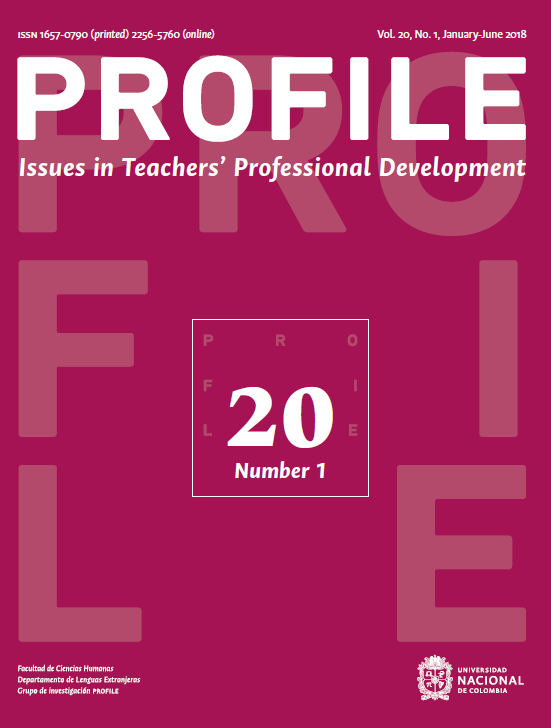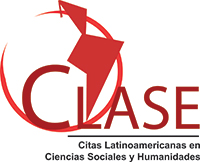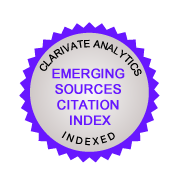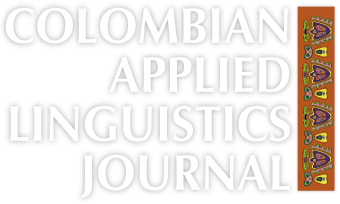Classroom Management in Foreign Language Education: An Exploratory Review
El manejo del salón de clases en la educación en lenguas extranjeras: una revisión exploratoria
DOI:
https://doi.org/10.15446/profile.v20n1.60001Keywords:
Foreign language instruction, classroom management, target language use (en)instrucción en lenguas extranjeras, manejo de clase, uso de la lengua objeto de estudio (es)
Classroom Management in Foreign Language Education: An Exploratory Review1
El manejo del salón de clases en la educación en lenguas extranjeras: una revisión exploratoria
Diego Fernando Macías*
Universidad Surcolombiana, Neiva, Colombia
This article was received on September 11, 2016, and accepted on May 29, 2017.
How to cite this article (APA, 6th ed.):
Macías, D. F. (2018). Classroom management in foreign language education: An exploratory review. Profile: Issues in Teachers’ Professional Development, 20(1), 153-166. https://doi.org/10.15446/profile.v20n1.60001.
This is an Open Access article distributed under the terms of the Creative Commons license Attribution-NonCommercial-NoDerivatives 4.0 International License. Consultation is possible at https://creativecommons.org/licenses/by-nc-nd/4.0/.
This review examines studies in the area of classroom management in foreign language education. It is organized into three large areas: The first area focuses on the distinctive characteristics of foreign language instruction that are more likely to impact classroom management in foreign language classes. The second area provides a description of classroom management issues that foreign language teachers usually encounter in their practice; and the third area centers on the different alternatives to reduce the negative impact of classroom management on foreign language classes. Conclusions suggest a need for more research particularly on the relationship between classroom management and aspects such as target language use and teaching methods.
Key words: Foreign language instruction, classroom management, target language use.
Esta revisión examina estudios en el área del manejo de clase en la educación en lenguas extranjeras. Está organizada en tres áreas: La primera aborda las características particulares de la instrucción en lenguas extranjeras que más impactan el manejo de clase. La segunda describe aspectos del manejo de clase que docentes de lenguas extranjeras usualmente encuentran en su práctica; y la tercera presenta alternativas para reducir el impacto negativo del manejo de clase en el área de lenguas extranjeras. Las conclusiones sugieren más investigación particularmente sobre la relación entre el manejo de clase y el uso de la lengua extranjera y métodos de enseñanza.
Palabras clave: instrucción en lenguas extranjeras, manejo de clase, uso de la lengua objeto de estudio.
Introduction
Classroom management appears to be one of the most recurring teachers’ concerns, namely for beginning teachers. This may be related to the fact that “the ideals that the beginning teacher formed during teacher training are replaced by the reality of school life where much of their energy is often transferred to learning how to survive in a new school culture” (Farrell, 2006, p. 212). Issues such as classroom discipline, dealing with individual differences and mixed-ability classes, organization of class work, relationships with parents, insufficient and/or inadequate teaching materials, overcrowded classrooms, sitting arrangement, noise, and social and cultural activities (Sariçoban, 2010; Veenman, 1984), to name a few, usually get in the way of teachers, especially in their initial years of teaching. In many settings, such issues tend to constitute real challenges that all teachers must learn to cope with.
Despite the vast amount of research on classroom management from a general education perspective, the particular impact of foreign language instruction on classroom management issues appears to be rather scarce. Teacher educators in foreign language programs and foreign language teachers themselves must be aware of the impact that particular features of foreign language instruction such as target language use, interaction patterns, and communicative competence can have on the process of managing the classroom. These features ought to be examined in terms of how they may hinder or facilitate the development of classroom management skills. This is absolutely relevant as prospective foreign language teachers are often taught to promote the above features in their classes while seeking to maintain adequate classroom management. Conducting this exploratory review then helps to consolidate the view of classroom management as a constant concern for those involved in teacher education, and it raises awareness among future and in-service foreign language teachers to be prepared to successfully respond to the many conflicting issues and situations inherent to the classroom environment.
Before proceeding any further, it is relevant to make reference here to the conception of classroom management. Brophy (1996) referred to classroom management as “actions taken to create and maintain a learning environment conducive to successful instruction” (p. 5) while Marzano (2003) stated that it consisted of the integration of four areas: “establishing and reinforcing rules and procedures, carrying out disciplinary actions, maintaining effective teacher and student relationships, and maintaining an appropriate mental set for management” (p. 88). Similarly, Doyle (1986) affirmed that “management is commonly viewed as a pre-requisite to instruction, something to get out of the way so that teaching can occur” (p. 394) and Crookes (2003) further highlighted the importance of a relatively orderly classroom, or at least as he claims; “one in which whatever superficial manifestations of disorder may occur either do not prevent instruction and learning, or actually support them” (p. 144). In short, most of the previous conceptions of classroom management highlight the construction of an appropriate atmosphere in the classroom so that teaching and, consequently, learning can occur.
This paper provides a review of this complex phenomenon of classroom management in relation to the field of foreign language education. I will start by offering a brief account of the methodology I used to conduct this review. After that, I will describe how research in classroom management has evolved in general education with emphasis on the most significant contributions. Then, I will present a synthesis of the main features of the foreign language classroom followed by reference to the distinctive aspects of classroom management in foreign language education. Next, I will focus on how research has described or characterized classroom management in foreign language education and the ways or mechanisms that various studies have proposed to reduce its impact. Finally, I will draw conclusions and offer suggestions for what might constitute potential avenues of research on classroom management in foreign language education.
Procedure
In the context of this review, I initially consulted Google Scholar and then complemented my search with various databases including ERIC and Education Full Text. I entered the keywords “classroom management” and “foreign language education/teaching” and found articles in various general journals (such as Teaching and Teacher Education, and System) and more subject-matter specific journals (such as ELT Journal and Foreign Language Annals). After a careful examination of 29 articles from nine journals and eight books and book chapters, I decided to exclude those that did not report results of research or that had serious limitations in terms of providing information about essential components of the research process.
Although it was not difficult to find books on the subject of classroom management in foreign language education, most of these (Farrell, 2008; Marzano, Gaddy, Foseid, Foseid, & Marzano, 2005; Scrivener, 2012) were how-to books focused on offering quick prescriptions and practical tips or activities to help language teachers cope with issues of classroom management in their teaching. In contrast, there were not many books that specifically address the phenomenon of classroom management in the field of foreign language education from a theoretical or research perspective. Wright’s (2005) Classroom Management in Language Education was without a doubt, a unique exception and an influential source in this review. Likewise, the chapter by Brophy (2006) in Evertson and Weinstein’s (2006) Handbook of Classroom Management also provided a nice historical review of the literature on classroom management although from a general education point of view.
The final corpus of the study regarding classroom management in the foreign language classroom was composed of 19 publications—fourteen articles from seven journals, two books, two book chapters, and a doctoral dissertation, all of which are referred to throughout this paper. Some publications on foreign language methodology and classroom management from a general educational perspective were additionally considered due to their relevance for understanding classroom management issues. The main shortcomings of the review had to do with restricted access to some publications within my working context; and a lack of examination of other studies on teaching methods (e.g., task-based language learning, content and language integrated learning) that may directly or indirectly deal with classroom management issues. Thus, the present study may be better understood as an exploratory review.
Classroom Management From a General Education Perspective
Research on classroom management in foreign language education appears to be noticeably missing from the large amount of literature on classroom management in general education. In examining the content of the Handbook of Classroom Management (Evertson & Weinstein, 2006), I did not find a single chapter that addressed the issue of classroom management from a language education perspective. It appears that “the literature has taken the issue of classroom discipline or behaviors of resistance in language classes for granted” (Crookes & Schmidt as cited in Rahimi & Hosseini, 2012, p. 310). It could also be the case that the literature perceived classroom management as inherently equal to all subject matter areas and so ignored the distinctive characteristics of classroom management for specific content areas.
In a historical review of research on classroom management, Brophy (2006) outlined various periods in the development of classroom management, beginning with an emphasis on habit formation and less importance on aspects such as self-regulation and cooperative learning in early 1900s. Brophy claimed that there was little research on classroom management until the 1950s when there seemed to be more concerns for involving students in developing rules and procedures, and helping them achieve appropriate levels of internal self-control. Brophy equally stated that a balance between authoritarian and laissez-faire approaches to classroom management began to evolve around this time. Initial actions towards this balance came from behavioral and ecological studies. Accordingly, behavioral studies promoted the use of techniques to increase students’ desired behavior (e.g., token reinforcement program, praise and approval, establishing clear rules and directions, etc.) and procedures to decrease undesired behavior (e.g., extinction, self-reprimands, time out from reinforcement, etc.).
Ecological studies held the idea that classrooms were environmental settings and so, according to Brophy (2006), relied on the assumption that “one needs to take into account the affordances and constraints created by teachers, peers, and other human actors, not just the settings’ physical characteristics” (p. 27). A significant contribution during this time was Kounin’s (1970) Discipline and Group Management in Classrooms where the author presented results and conclusions of various research studies. One of such studies focused on how a teacher’s method of managing the behavior of a student influenced other students as they comprised the audience of the event; this came to be known as the ripple effect in discipline, while another study consisted of videotaping classroom lessons aimed at studying disciplinary techniques. Kounin also suggested that there were several dimensions of teacher behaviors that affected the behavior of students. For example, “withitness” (or the teacher’s being aware of what is happening everywhere in the classroom at all times), overlapping (or attending to two issues at the same time), transition smoothness (or absence of dangles, thrusts), and planning for learning-related variety in seatwork.
Brophy (2006) then stated that process-outcome studies took place during the 1960s and through the 1980s. These studies focused on the effects or outcomes of teacher actions and student interaction patterns and adapted concepts and ideas from Kounin’s work. Other relevant work on classroom management during this time was Doyle’s (1984) research on successful classroom managers, and Glasser’s (1990) Choice Theory model, which considered individuals as capable of making their own choices in terms of their behaviors and based on their needs and feelings. In short, Brophy pointed out that research on classroom management had been of very good quality. It had moved from inculcating good behavior habits to engagement in learning activities; from reactive discipline to proactive installation of desired procedures and routines; and from unilateral teacher control to development of students’ capacities for exercising responsibility and self-regulation. Brophy also concluded that management that was preventive, that clarified what students were expected to do and helped them do it was more likely to be effective than management that focused on misbehavior and after-the-fact discipline.
Approaches to Foreign Language Teaching
Understanding classroom management issues in foreign language education requires an examination of the theoretical approaches and teaching methods that have characterized foreign language learning and teaching. Thus, this section makes a brief reference to such approaches and methods in an attempt to understand how they may impact classroom management.
Researchers in second language acquisition have, to a great extent, been guided in their thinking by the several theoretical approaches to the study of first language acquisition. Bohannon and Bonvillian (2008) provide a rich description of the main approaches (behavioral, linguistic, and interactionist) to the study of second language acquisition. In that order, behavioral approaches focus on the observable and measurable conditions of language behavior whereas language development is a matter of “linking various stimuli in the environment to internal responses, and these internal responses to overt verbal behavior” (p. 261). Teachers view learners typically as passive recipients of environmental pressures. In contrast, linguistic approaches emphasize that language has a structure or grammar. Proponents claim the existence of a set of universal grammar rules while individuals are naturally endowed to learn a second language by progressively testing their own evolving grammars against the data provided by the environment. Interactionist approaches, added Bohannon and Bonvillian, assume that many factors (linguistic, social, biological, cognitive, etc.) interact and modify each other and therefore affect the course of language acquisition and development. The interactionist approaches are further divided into cognitive interactionist and social interactionist approaches. The former see language as emerging from or closely tied to advances in children’s cognitive development whereas the latter view language development “as an orderly, although complex, interactive process where social interaction assists language acquisition and the acquisition of language allows more mature social interaction” (Bohannon & Bonvillian, 2008, p. 292).
Wright (2005) also talks about three models of teaching: transmission, exploration, and social constructivism. Teaching as transmission is characterized by teacher control of the learning context in which teachers emphasize students being seated facing the teacher, memorization, rote learning, drills, and question-and-answer practices. Exploratory teaching puts the learner at the center and the teacher is responsible for “assisting learners in designing for themselves the selection, pace and evaluation of appropriate learning experiences” (p. 201). Wright further highlights “the individual learner’s direct experience through which they ‘discover’ new knowledge and formulate their own ideas and meanings, as ‘active scientists’” (p. 201). In contrast, social constructivism stresses the role of the social context of learning and collaborative work so that students constantly engage in talk (Wright, 2005).
The previous theoretical approaches and models have served as the foundations to a large plethora of methods and approaches to foreign language teaching. Richards and Rodgers (2001) outline a chronology of the most significant teaching methods in this field. Interestingly, language teachers and teacher educators have witnessed how each new language teaching method promotes the belief that the teaching practices it supports provide a more effective alternative for teaching than the methods that came before it (Richards & Rodgers, 2001). All in all, there has been a move from grammar-based teaching methods towards more communicative approaches in foreign language teaching. Grammar-based methodologies accentuated aspects such as analysis and memorization of grammar rules, translating texts into and out of the target language, reading and writing in the target language, using the students’ native language, and teaching grammar deductively. In contrast, communicative approaches advocate aspects such as learning to communicate, comprehensible pronunciation, dialogues centered on communicative functions. Communicative competence is the desired goal; students are expected to interact with other people, and the target language is learned by constantly struggling to communicate. Wright (2005) points out that the methodologies or teaching models used by teachers can be inferred from observing “the different types of activity they use, the order in which they use them and the ways in which participation in classroom talk is managed” (p. 190).
This evolution in teaching approaches and methods in language education has come to represent a transition from teacher-centered to learner-centered approaches advocated by foreign language teachers worldwide. Interestingly, every new teaching method has brought implications and consequences for classroom management as elements such as teachers’ and learners’ roles, interaction patterns, and target language use tended to vary across such methods and therefore affected classroom management in different ways. The relationship between teaching approaches or methods and classroom management becomes even more challenging as teachers almost never followed one methodology to the exclusion of others. In fact, Wright (2005) argues that “teachers use a fairly wide variety of teaching activities, however; [they] seem to gravitate towards a set of shared beliefs and assumptions about what constitutes ‘good practice’, from which a common pedagogy emerges” (p. 192). I will return to the connection between teaching methods and classroom management later in this paper.
Distinctive Characteristics of Classroom Management in Foreign Language Education
Despite the fact that managing the classroom is an inherent aspect to the teaching profession and therefore makes its presence across all content areas, I believe that there are particular or unique features of the foreign language teaching profession that may have an impact on classroom management. To begin with, Borg (2006) identified eleven characteristics that distinguish language teachers from teachers of other subjects; I have highlighted below those I consider are most likely to affect classroom management (p. 24):
- Foreign language teaching is the only subject where effective instruction requires the teacher to use a medium (language) the students do not yet understand.
- Effective foreign language instruction requires interaction patterns such as group work, which is desirable but not necessary for effective instruction in other subjects.
- The methodology of language teaching is more diverse and aimed at creating contexts for communication and maximizing student involvement.
As can be observed, aspects such as target language use, patterns of interactions, and teaching methodologies constitute distinctive features in foreign language education and therefore may impact classroom management in various ways. Given the lack of research on how interaction patterns and teaching methodologies affect classroom management in foreign language education and the limited scope of this paper, I have decided to focus on how using the target language as the medium of instruction and overall communication in class impacts classroom management.
The use of the target language in the classroom has traditionally been emphasized in the foreign language teaching profession mainly in view of contemporary teaching methods that advocate a communicative orientation in language teaching. Mercer (2001) highlights teachers’ use of language as the principal tool of their responsibilities which may include controlling unruly behavior, teaching a specific curriculum, and monitoring and assessing students’ progress. Allwright and Bailey (1991) also state that performing in a foreign language class is in a way more stressful than performing in other subject classes.
In mathematics, for example, you may get the answer wrong, but at least you can be reasonably sure of saying the numbers correctly. In language work, by contrast, even if in a sense you get the answer right (you find the correct form of the verb, say, in a blank-filling item) you may still make an almost infinite number of mistakes in what you say—for example, with imperfect pronunciation of individual sounds, wrong word stress, wrong sentence stress, and so on...In short, the risk of making a fool of yourself in a language class is very high, and you need to be a singularly robust character to avoid being affected adversely by feelings of anxiety in such a setting. (p. 174)
From conducting my own search, I found that few studies have addressed the impact of first or target language use on managing the foreign language classroom. For example, Kang (2013) explored how English as a foreign language (EFL) teachers used their first language and/or the target language for classroom discipline. The study involved the participation of two EFL teachers at two elementary schools in Korea. Kang investigated the significance of the differences between first language (L1) and target language (TL) use for two EFL teachers at two elementary schools in Korea. One of the teachers demonstrated using more the TL as opposed to the L1 for disciplinary purposes. Kang concluded that low-level students found TL use to be difficult to comprehend, and claimed that it influenced their behavior little whereas high-level students considered it helpful in increasing their target knowledge, and in increasing their respect for the teacher’s proficiency and their obedience to her. This teacher’s shift to more TL use seemed to “constitute her effort to reclaim her position as the authority figure, irrespective of its actual effectiveness for initiation and sustainment of classroom discipline” (p. 156). The other teacher employed more the L1 than the TL for classroom discipline which was connected to her lack of TL proficiency, and to the considerable unruliness of her students. In contrast, the students expressed that their lack of comprehension of the content that the teacher taught got them to engage in noisy chatter. Another teacher similarly admitted that her anxiety incited her to depend more on the L1 for classroom discipline.
Evans (2012) similarly contended that the foreign language classroom led both pre-service and in-service teachers into management issues that were uncommon or did not exist in other content area classrooms. She worked with five participants who had been student teachers for one semester from the fall of 2006 to the spring of 2010, and were currently working as in-service foreign language teachers. Evans found that TL use is a variable that positively affected student behavior. However, she cautioned that the use of the TL may not always be a winning classroom management strategy for foreign language teachers. The study equally allowed the identification of other particular or exclusive aspects in foreign language education (e.g., the lack of respect for the study of foreign language, and the inclusion of students who were heritage speakers of the TL) that may influence classroom management issues.
Other studies (Bateman, 2008; Nation, 2003; Wilkerson, 2008) have examined the use of the L1 and the TL in foreign language education. Although classroom management has not been a central concern for these authors, the studies have served to establish a clear connection between L1 or TL use and several other aspects of foreign language teaching including classroom management. Nation (2003) justified using the TL in the classroom on the basis that learners did not usually have the chance to use the TL outside the classroom, and insisted that classroom management was one way to promote TL use in class. This could include controlling behavior, explaining activities, and giving directions or instructions. Nation also argued that “if the use of English [as the target language] in classroom management is done in a planned, consistent way, then classroom management can be a very effective opportunity for learning through meaning focused input” (p. 2).
Bateman (2008) found that classroom management significantly contributed to the avoidance of the TL by student teachers at a private university who were worried that they would lose control of the class if they did not use their L1. Interestingly, one of the participants in this study indicated that “her mentor teacher had asked her to focus on classroom management instead of using the target language” (Bateman, 2008, p. 19). In this regard, the National Association of District Supervisors of Foreign Languages (n.d.) argued that a teacher’s use of [L1] to establish control had uniquely detrimental effects in the language classroom since students were supposed to communicate, take risks, and engage in meaningful interactions and tasks in the TL.
Wilkerson (2008) also focused on the use of English as the first language in a couple of Spanish as a foreign language courses in the United States. The study sought to understand why language instructors used English as the students’ L1 while teaching. Different from the previous studies, these teachers did not claim a lack of proficiency in the TL as one of the reasons to avoid its use. Instead, they used the L1 “to save time, demonstrate authority, and reduce ambiguity” (p. 315). Wilkerson indicated that participant teachers used the L1 to manage aspects of the classroom such as controlling the speed of classroom interactions, eliminating waiting or lag time, and limiting students’ turn taking.
This section has focused on the role that TL use plays in managing the foreign language classroom. Despite the widespread demand for TL use to manage all the processes in the foreign language classroom, many teachers still tend to use the students’ L1 for purposes of classroom management. Even though lack of TL proficiency was an aspect identified in some studies as one of the reasons for teachers to be reluctant to use the TL, the fact remains that using the L1 appears to offer teachers better control of the learning environment and reduces the risk of inappropriate behavior and ambiguity. Nonetheless, the field of foreign language education needs more research to examine the role or impact of the TL on managing the classroom especially in view of the results presented by Kang (2013) between low-level and high-level learners.
Features of Classroom Management in Foreign Language Education
Various studies (Burnett, 2011; Evans, 2012; Eveyik-Aydın, Kurt, & Mede, 2009; Farrell, 2003; Macías & Sánchez, 2015; Quintero & Ramírez, 2011; Wadden & McGovern, 1991) have sought to identify and characterize the phenomenon of classroom management in foreign language teaching. Some studies have attempted to document the existence of classroom management as a pressing concern, a frequent struggle, and a serious challenge mainly for beginning foreign language teachers (Balli, 2009; Quintero & Ramírez, 2011; Lewis, 2002). They have focused on teachers’ beliefs, views, and experiences in terms of classroom management; typical examples of students’ misbehavior; and the influence of previous teacher preparation coursework on teachers’ classroom management skills, among other issues.
Overall, those studies offer a rich description of the many aspects that are usually involved in classroom management from various perspectives. Wadden and McGovern (1991) introduced the term negative class participation to refer to classroom misbehavior, and identify examples of students’ misconduct including “disruptive talking and sleeping in class...persistent inaudible response and unwillingness to speak in the target language” (p. 119). Clearly, although most of the previous examples of student misbehavior may occur across all content areas, there are others such as unwillingness to speak in the TL that would pertain solely to foreign language education. It is by establishing clear rules or guidelines and sticking to them from the beginning that language teachers can solve problems associated with negative class participation, the authors concluded.
The first part of Quintero and Ramírez’s (2011) project looked at how five EFL teacher trainees understood, explained, characterized, and dealt with discipline-related challenges in public school classrooms in Colombia. These teachers conducted action research projects at public schools in urban areas that serve low social stratum neighborhoods. Quintero and Ramírez found that public school classrooms represented a difficult world where situations involving “complaints, arguments, varying emotions, confusion, conversation, and playing” (p. 66) abound. Most trainees in the study stated that their enthusiasm to learn and teach was brutally destroyed by sometimes minor and sometimes serious student misbehavior that hurt their self-esteem and made them feel frustrated. One of the most interesting findings in the previous study had to do with teacher trainees feeling unrecognized as figures of authority in class, presumably due to their young age and inexperience. Macías and Sánchez (2015) found a similar issue in working with pre-service EFL teachers in Colombia. These teachers reported still seeing themselves as college students as opposed to teachers, a perspective which was perceived as an obstacle for gaining classroom management skills. Other challenges, possibly more inherent to foreign language education, that affected these pre-service teachers’ classroom management included students’ negative attitude towards the foreign language and their apparent low level of TL proficiency.
Two other studies involved the participation of a beginning EFL teacher in Singapore (Farrell, 2003), and a more experienced EFL teacher in Turkey (Eveyik-Aydın et al., 2009). Farrell (2003) investigated the role that support (from the school and colleagues) played during the teacher’s first year teaching whereas Eveyik-Aydın et al. (2009) researched the relationship between the teacher’s classroom management beliefs and her actual teaching practices. Although Farrell did not focus explicitly on classroom management, it indirectly touched on this issue as one of the many compelling challenges that beginning teachers experienced in their first year of professional language teaching.
Findings in Farrell’s (2003) study in regard to classroom management were related to the phases this teacher went through during that year. Accordingly, the teacher moved from an early idealism as he wanted to connect and make a difference in his students’ lives, to experiencing some shock from the reality of the classroom as he moved through his first semester. In an attempt to survive this phase, this teacher sought quick fixes for the discipline problems he experienced in one of his classes, but he still encountered some difficulties with the class and his communication with his colleagues. He then moved to a phase of beginning to recognize these difficulties and causes as he also wondered if he would make it as a teacher. As the first year progressed, this teacher began to cope better with his classes (his teaching methods and classroom management). On the other hand, results of Eveyik-Aydın et al.’s (2009) study showed that the teacher had interactionalist orientations (that is, she considered that students and teachers should both be responsible for managing the classroom) on instructional and people management while she had interventionist beliefs (that is, she believed that students master proper behavior mainly when such behavior are reinforced by a system of rewards and punishments) on behavior management.
The studies conducted by Burnett (2011) and Evans (2012) involved more than one participant, and also sought to obtain teachers’ views in regard to various issues associated with classroom management in foreign language teaching. Burnett (2011) focused on two practicing language teachers working in public schools in Southern Mississippi. One of these two teachers revealed that much of what she had learned in previous graduate coursework did not apply to the classroom since most of her talk centered on controlling out-of-turn talking by students. Similarly, both participant teachers in the same study used several strategies to deal with student misbehavior including telling the students they would have a quiz if they did not behave properly, moving a student’s desk by the teacher’s desk, giving detentions and calling on principals, counselors, and parents for help. In contrast, Evans (2012) noted that all five teachers in the study had a very positive view of their teacher education coursework. They believed that it had provided them with powerful tools to understand and deal with classroom management issues.
The studies in this section present a general view of the many aspects that characterize classroom management in the field of foreign language education. These studies have offered a description of this phenomenon from the perspectives of beginning teachers to a large extent and of more experienced foreign language teachers to a lesser extent. Studies by Evans (2012) and Wadden and McGovern (1991) served to confirm that foreign language teachers often face classroom management issues that appear to be exclusive to the field of foreign language education. For example, issues such as inaudible responses, unwillingness to communicate in the target language, lack of respect for the study of foreign languages, and the inclusion of students who were heritage speakers of the TL, are likely to have a significant impact on foreign language teachers’ classroom management skills. Studies by Burnett (2011) and Evans (2012) led to a divided opinion in relation to the influence of previous preparation coursework on how teachers manage their classrooms.
Reducing the Impact of Classroom Management Problems in Foreign Language Education
Research on classroom management in foreign language education has also focused on providing ways or mechanisms to help foreign language teachers reduce the impact of classroom management issues in their courses. Soares (2007) replicated an action research study of her own aimed to reduce the negative class participation of a group of misbehaving and unmotivated EFL students in a language school in Brazil. She concluded that building rapport and developing awareness-raising activities constituted an effective way to minimize behavior problems in the foreign language classroom, especially regarding aspects previously identified by Wadden and McGovern (1991) such as disruptive talking, incomplete homework, and unwillingness to speak only English in class. The author highlighted that teachers had to learn to “value students as individuals and show them they are capable of going beyond their perceived limitations” (Soares, 2007, p. 53). Similarly, teachers had to help students to understand that they were responsible for constructing a positive learning environment by contributing their share to it.
Two other survey studies (Fowler & Sarapli, 2010; Rahimi & Hosseini, 2012) aimed to investigate EFL students’ perspectives and expectations of their teachers’ classroom management strategies and techniques. Findings in Rahimi and Hosseini’s (2012) study revealed that EFL teachers used recognition and reward most often and punishment and aggression less frequently when dealing with misbehavior in their classes. The study similarly indicated that public school female teachers tended to use aggression as a strategy more than teachers in private schools. On the other hand, Fowler and Sarapli (2010) found that effective classroom management was just as important to English language students as it was to teachers, and that a rather strict classroom where teachers valued and respected students was usually expected by students. The authors added that EFL students also claimed that they needed to know what teachers expected of them in terms of their behavior and fair testing practices.
Waters (1998) claimed that an understanding of the “monkey”, a concept from management studies used to denote the “next move” in a problem-solving process, could help to ease the problem of classroom management in English language teaching. The monkey management system established that priority should be given to who should solve the problem. In the context of foreign language teaching, it often happens that the teacher accepts responsibility for solving problems that students should solve. In other words, “if teachers solve problems for their learners which they can solve for themselves, they collect their learners’ monkeys. As a result, they soon become overworked, while the learners sit back and take it easy” (Waters, 1998, p. 13). Waters stressed that developing appropriate monkey management attitudes in class may lead teachers to put a learner-centered approach to classroom management into practice in English language teaching.
Other studies (Castellanos, 2002; Quintero & Ramírez, 2011) have also identified a great variety of ways or strategies to help foreign language teachers reduce the impact of classroom management problems in the courses they teach. Participants in Quintero and Ramírez’s (2011) study emphasized talking with the involved students, including providing a variety of activities in lessons, maintaining students’ attention, giving clear explanations and instructions, keeping learners busy, and managing time wisely were among the strategies they used to deal with discipline problems. Castellanos (2002) revealed a series of strategies such as focusing, monitoring, modeling, non-verbal cueing, environmental control, and assertive and positive discipline, among others, that may contribute to better classroom management. This study took further significance as it offered support to the importance of working on students’ self-esteem and teachers playing fair as factors that contribute to reduce children’s level of aggressiveness and to construct a positive classroom environment.
This section has looked at different ways or mechanisms that research has contributed to help foreign language teachers better cope with classroom management issues. Interestingly, some of the suggested mechanisms may result in the application of particular concepts or frameworks such as Waters’ (1998) monkey concept while others advocate teachers’ new dispositions such as abandoning punishment and aggression in favor of more recognition and reward (Rahimi & Hosseini, 2012) or promoting students’ self-esteem and responsibility in maintaining a positive learning environment (Castellanos, 2002; Soares, 2007). The story structure framework (Farrell, 2006) may also help to create a safe and non-judgmental support system for foreign language teachers to share their emotional burden and isolating experiences when they first enter the world of teaching. This story structure framework, according to Farrell, follows a pattern of setting-complication-resolution where the setting addresses questions such as: Who was involved? What took place? When did it take place? The complication centers on the problem that arose together with critical moments in the story and the resolution focuses on how the teacher dealt with those complications. Sources such as those I mentioned earlier in this paper (Farrell, 2008; Marzano et al., 2005; Scrivener, 2012) offer more concrete tasks and activities intended to help foreign language teachers alleviate classroom management issues. However, I would encourage foreign language teachers to be cautious about implementing quick fix solutions to classroom management issues without previously considering the circumstances of their teaching contexts.
Discussion and Conclusions
Within the scope of this literature review, research on classroom management in foreign language education has followed predominantly qualitative methodologies with a particular emphasis on case studies, and has involved the use of classroom observations, interviews, questionnaires, journals, and field notes. Furthermore, most studies have relied on the participation of foreign language students, student teachers, beginning teachers, and in-service teachers of mainly English and, in a couple of cases, Spanish as foreign languages. Most of the studies were also conducted from an etic perspective where the researchers were university faculty, practicum supervisors, or outside teachers and “experts” investigating classroom management in a context they had connections with.
The review points out the existence of distinctive aspects of the field of foreign language teaching that may affect classroom management in particular ways. These aspects include TL use, interaction patterns, teaching methods, the inclusion of heritage speakers of the TL (particularly in the case of Spanish as a foreign language in the United States), and the lack of respect for the study of a foreign language. It follows that no other aspect seems to have gained more attention that the use of the TL in the foreign language classroom. However, despite the vast amount of research on the use of L1 or TL in the foreign language classroom (Littlewood & Yu, 2009; Nation, 2003; Wilkerson, 2008), very few (Evans, 2012; Kang, 2013) have looked at it from the perspective of the implications for classroom management. The other distinctive aspects of foreign language education that may impact classroom management appear to have received little or no attention in the literature. Teaching methods and approaches have nonetheless been of particular relevance here as they are likely to influence the classroom management skills teachers need to develop in response to more particular aspects of teaching such as class activities, materials, patterns of interaction, and teachers’ and students’ roles.
In relation to the description or characterization of classroom management in foreign language education, I feel that most studies have focused on reaffirming the existence of classroom management problems in foreign language teaching. These studies have offered lists of issues or problems that foreign language teachers typically encounter in their lessons, how these problems affect teachers, how they deal with them from their own perspectives, the beliefs and views they have of classroom management, and how their previous teacher preparation coursework has influenced their classroom management practices. I nonetheless believe that these studies can help to obtain an overview of what characterizes classroom management in foreign language education. It is important to realize that many of the problems in classroom management in foreign language classes identified throughout the literature (e.g., insufficient or inadequate materials and resources, overcrowded classrooms, etc.) clearly coincide with problems teachers of other content areas usually confront, while other issues (e.g., unwillingness to speak in the target language, students at different levels of language proficiency) pertain almost exclusively to the area of foreign language education.
Many of the actions suggested in the studies reviewed seem to come from teachers’ own experiences in the context of the research projects or from ideas established previously in the literature in general education or in other fields. For instance, some of the alternatives for teachers to cope with classroom misbehavior in various studies seemed rather prescriptive and dogmatic. They emphasized the promotion and awareness-raising actions of rules or guidelines usually established by the teacher with no apparent student participation or involvement in the making of such rules.
Teacher preparation programs usually continue to promote theories and practices which revolve around the concept of the ideal learner (Soares, 2007) and so turn a blind eye to issues of classroom misbehavior in actual foreign language classrooms. This leaves teachers, particularly beginning teachers, with “little but their intuition to guide them” (Soares, 2007, p. 43). I consider there should be more concern about the potential implications of coping (or not) with classroom misbehavior in foreign language education. It is the responsibility of all those involved in teacher preparation to guide new teachers in designing and implementing alternatives to confront those particular aspects that may influence classroom management in the teaching and learning of foreign languages.
Directions for Further Research
Despite the great amount of research on classroom management from a general education perspective, there seems to be ample need for research on various features of foreign language education in terms of how they impact classroom management for teachers in various positions. Issues related to TL use, patterns of interaction, and teaching methods are in need of being investigated from the perspective of the influence they can have on classroom management issues in foreign language education.
To further illustrate, a particular research initiative could examine the connection between classroom management problems and the teaching method used by foreign language teachers. This is particularly relevant in the light of the principles emphasized by communicative approaches in language teaching. A study of this nature may contribute to validate the assumption that the teaching method(s) that teachers choose to follow will in a great part determine the classroom management challenges they will encounter in their practice.
There is also a need to investigate classroom management issues in the foreign language classroom from an emic perspective, that is, from teachers themselves as researchers. Teachers are in a unique position to investigate issues of their immediate teaching setting. I have come to realize that teachers can do a lot for their own professional development if they seriously assume the role of researchers of their own classrooms.
Analysis of the classroom management approach that foreign language teachers rely on equally constitutes another avenue of inquiry. It may be interesting to generate opportunities for foreign language teachers to characterize and reflect on their own approach to managing the classroom so that they can find possible connections with those more distinctive features of foreign language instruction that may affect classroom management.
1This article is a revised version of a paper submitted by the author as part of the activities of the doctoral studies he was involved in at the University of Arizona.
References
Allwright, D., & Bailey, K. M. (1991). Focus on the language classroom. Cambridge, UK: Cambridge University Press.
Balli, S. J. (2009). Making a difference in the classroom: Strategies that connect with students. Lanham, US: Rowman and Littlefield.
Bateman, B. E. (2008). Student teachers’ attitudes and beliefs about using the target language in the classroom. Foreign Language Annals, 41(1), 11-28. https://doi.org/10.1111/j.1944-9720.2008.tb03277.x.
Bohannon, J., & Bonvillian, J. (2008). Theoretical approaches to language acquisition. In J. B. Gleason & N. Bernstein (Eds.), The development of language (pp. 254-314). Boston, US: Allyn and Bacon.
Borg, S. (2006). The distinctive characteristics of foreign language teachers. Language Teaching Research, 10(1), 3-31. https://doi.org/10.1191/1362168806lr182oa.
Brophy, J. (1996). Teaching problem students. New York, US: Guilford.
Brophy, J. (2006). History of research on classroom management. In C. M. Evertson & C. S. Weinstein (Eds.), Handbook of classroom management: Research, practice, and contemporary issues (pp. 17-43). New York, US: Routledge.
Burnett, J. (2011). Two case studies of secondary language teaching: A critical look at the intersection of management and the local and social realities that shape our classrooms. The Modern Language Journal, 95(s1), 4-26. https://doi.org/10.1111/j.1540-4781.2011.01240.x.
Castellanos, A. (2002). Management of children’s aggressiveness when playing competitive games in the English class. Profile: Issues in Teachers’ Professional Development, 3(1), 72-77.
Crookes, G. (2003). A practicum in TESOL: Professional development through teaching practice. New York, US: Cambridge University Press.
Doyle, W. (1984). How order is achieved in classrooms: An interim report. Journal of Curriculum Studies, 16(3), 259-277. https://doi.org/10.1080/0022027840160305.
Doyle, W. (1986). Classroom organization and management. In M. C. Wittrock (Ed.), Handbook of research on teaching (3rd ed., pp. 392-431). New York, US: Macmillan.
Evans, E. J. (2012). Managing the foreign language classroom: reflections from the preservice field and beyond (Doctoral dissertation). The University of Iowa, Iowa City, US.
Evertson, C. M., & Weinstein, C. S. (2006). Handbook of classroom management: Research, practice, and contemporary issues. New York, US: Routledge.
Eveyik-Aydin, E., Kurt, G., & Mede, E. (2009). Exploring the relationship between teacher beliefs and styles on classroom management in relation to actual teaching practices: a case study. Procedia: Social and Behavioral Sciences, 1(1), 612-617. https://doi.org/10.1016/j.sbspro.2009.01.109.
Farrell, T. S. C. (2003). Learning to teach English language during the first year: Personal influences and challenges. Teaching and Teacher Education, 19(1), 95-111. https://doi.org/10.1016/S0742-051X(02)00088-4.
Farrell, T. S. C. (2006). The first year of language teaching: Imposing order. System,34(2), 211-221. https://doi.org/10.1016/j.system.2005.12.001.
Farrell, T. S. C. (2008). Classroom management. New York, US: TESOL International Association.
Fowler, J., & Sarapli, O. (2010). Classroom management: What ELT students expect. Procedia: Social and Behavioral Sciences, 3, 94-97. https://doi.org/10.1016/j.sbspro.2010.07.017.
Glasser, W. (1990). The quality school: Managing students without coercion. New York, US: Harper & Row.
Kang, D.-M. (2013). EFL teachers’ language use for classroom discipline: A look at complex interplay of variables. System,41(1), 149-163. https://doi.org/10.1016/j.system.2013.01.002.
Kounin, J. S. (1970). Discipline and group management in classrooms. New York, US: Holt, Rinehart & Winston.
Lewis, M. (2002). Classroom management. In J. C. Richards & W. A. Renandya (Eds.), Methodology in language teaching: An anthology of current practice (pp. 40-48). New York, US: Cambridge University Press. https://doi.org/10.1017/CBO9780511667190.007.
Littlewood, W., & Yu, B. (2011). First language and target language in the foreign language classroom. Language Teaching, 44(1), 64-77. https://doi.org/10.1017/S0261444809990310.
Macías, D. F., & Sánchez, J. A. (2015). Classroom management: A persistent challenge for foreign language teachers. Profile: Issues in Teachers’ Professional Development, 17(2), 81-99. https://doi.org/10.15446/profile.v17n2.43641.
Marzano, R. J. (2003). What works in schools: Translating research into action. Alexandria, US: Association for Supervision and Curriculum Development.
Marzano, R. J., Gaddy, B. B., Foseid, M. C., Foseid, M. P., & Marzano, J. S. (2005). A handbook for classroom management that works. Alexandria, US: Association for Supervision and Curriculum Development.
Mercer, N. (2001). Language for teaching a language. In C. N. Candlin & N. Mercer (Eds.), English language teaching in its social context: A reader (pp. 243-257). London, UK: Routledge.
Nation, P. (2003). The role of the first language in foreign language learning. Asian EFL Journal, 5(2), 1-8.
National Association of District Supervisors of Foreign Languages. (n.d.). [Web site]. www.nadsfl.org.
Quintero, J., & Ramírez, O. (2011). Understanding and facing discipline-related challenges in the English as a foreign language classroom at public schools. Profile: Issues in Teachers’ Professional Development, 13(2), 59-72.
Rahimi, M., & Hosseini, F. K. (2012). EFL teachers’ classroom discipline strategies: The students’ perspective. Procedia: Social and Behavioral Sciences, 31, 309-314. https://doi.org/10.1016/j.sbspro.2011.12.060.
Richards, J. C., & Rodgers, T. S. (2001). Approaches and methods in language teaching. New York, US: Cambridge University Press. https://doi.org/10.1017/CBO9780511667305.
Sariçoban, A. (2010). Problems encountered by student-teachers during their practicum studies. Procedia: Social and Behavioral Sciences, 2(2), 707-711. https://doi.org/10.1016/j.sbspro.2010.03.088.
Scrivener, J. (2012). Classroom management techniques. Cambridge, UK: Cambridge University Press.
Soares, D. (2007). Discipline problems in the EFL class: Is there a cure? Profile: Issues in Teachers’ Professional Development, 8(1), 41-58.
Veenman, S. (1984). Perceived problems of beginning teachers. Review of Educational Research, 54(2), 143-178. https://doi.org/10.3102/00346543054002143.
Wadden, P., & McGovern, S. (1991). The quandary of negative class participation: Coming to terms with misbehavior in the language classroom. ELT Journal, 45(2), 119-127. https://doi.org/10.1093/elt/45.2.119.
Waters, A. (1998). Managing monkeys in the ELT classroom. ELT Journal, 52(1), 11-18. https://doi.org/10.1093/elt/52.1.11.
Wilkerson, C. (2008). Instructors’ use of English in the modern language classroom. Foreign Language Annals, 41(2), 310-320. https://doi.org/10.1111/j.1944-9720.2008.tb03294.x.
Wright, T. (2005). Classroom management in language education. New York, US: Palgrave MacMillan. https://doi.org/10.1057/9780230514188.
About the Author
Diego Fernando Macías works as an associate professor in the English Teacher Education Program at Universidad Surcolombiana. He is a Fulbright scholar currently pursuing his PhD in Second Language Acquisition and Teaching at the University of Arizona. His interests include teacher learning and classroom management in foreign language instruction.
References
Allwright, D., & Bailey, K. M. (1991). Focus on the language classroom. Cambridge, UK: Cambridge University Press.
Balli, S. J. (2009). Making a difference in the classroom: Strategies that connect with students. Lanham, US: Rowman and Littlefield.
Bateman, B. E. (2008). Student teachers’ attitudes and beliefs about using the target language in the classroom. Foreign Language Annals, 41(1), 11-28. https://doi.org/10.1111/j.1944-9720.2008.tb03277.x.
Bohannon, J., & Bonvillian, J. (2008). Theoretical approaches to language acquisition. In J. B. Gleason & N. Bernstein (Eds.), The development of language (pp. 254-314). Boston, US: Allyn and Bacon.
Borg, S. (2006). The distinctive characteristics of foreign language teachers. Language Teaching Research, 10(1), 3-31. https://doi.org/10.1191/1362168806lr182oa.
Brophy, J. (1996). Teaching problem students. New York, US: Guilford.
Brophy, J. (2006). History of research on classroom management. In C. M. Evertson & C. S. Weinstein (Eds.), Handbook of classroom management: Research, practice, and contemporary issues (pp. 17-43). New York, US: Routledge.
Burnett, J. (2011). Two case studies of secondary language teaching: A critical look at the intersection of management and the local and social realities that shape our classrooms. The Modern Language Journal, 95(s1), 4-26. https://doi.org/10.1111/j.1540-4781.2011.01240.x.
Castellanos, A. (2002). Management of children’s aggressiveness when playing competitive games in the English class. Profile: Issues in Teachers’ Professional Development, 3(1), 72-77.
Crookes, G. (2003). A practicum in TESOL: Professional development through teaching practice. New York, US: Cambridge University Press.
Doyle, W. (1984). How order is achieved in classrooms: An interim report. Journal of Curriculum Studies, 16(3), 259-277. https://doi.org/10.1080/0022027840160305.
Doyle, W. (1986). Classroom organization and management. In M. C. Wittrock (Ed.), Handbook of research on teaching (3rd ed., pp. 392-431). New York, US: Macmillan.
Evans, E. J. (2012). Managing the foreign language classroom: reflections from the preservice field and beyond (Doctoral dissertation). The University of Iowa, Iowa City, US.
Evertson, C. M., & Weinstein, C. S. (2006). Handbook of classroom management: Research, practice, and contemporary issues. New York, US: Routledge.
Eveyik-Aydin, E., Kurt, G., & Mede, E. (2009). Exploring the relationship between teacher beliefs and styles on classroom management in relation to actual teaching practices: a case study. Procedia: Social and Behavioral Sciences, 1(1), 612-617. https://doi.org/10.1016/j.sbspro.2009.01.109.
Farrell, T. S. C. (2003). Learning to teach English language during the first year: Personal influences and challenges. Teaching and Teacher Education, 19(1), 95-111. https://doi.org/10.1016/S0742-051X(02)00088-4.
Farrell, T. S. C. (2006). The first year of language teaching: Imposing order. System,34(2), 211-221. https://doi.org/10.1016/j.system.2005.12.001.
Farrell, T. S. C. (2008). Classroom management. New York, US: TESOL International Association.
Fowler, J., & Sarapli, O. (2010). Classroom management: What ELT students expect. Procedia: Social and Behavioral Sciences, 3, 94-97. https://doi.org/10.1016/j.sbspro.2010.07.017.
Glasser, W. (1990). The quality school: Managing students without coercion. New York, US: Harper & Row.
Kang, D.-M. (2013). EFL teachers’ language use for classroom discipline: A look at complex interplay of variables. System,41(1), 149-163. https://doi.org/10.1016/j.system.2013.01.002.
Kounin, J. S. (1970). Discipline and group management in classrooms. New York, US: Holt, Rinehart & Winston.
Lewis, M. (2002). Classroom management. In J. C. Richards & W. A. Renandya (Eds.), Methodology in language teaching: An anthology of current practice (pp. 40-48). New York, US: Cambridge University Press. https://doi.org/10.1017/CBO9780511667190.007.
Littlewood, W., & Yu, B. (2011). First language and target language in the foreign language classroom. Language Teaching, 44(1), 64-77. https://doi.org/10.1017/S0261444809990310.
Macías, D. F., & Sánchez, J. A. (2015). Classroom management: A persistent challenge for foreign language teachers. Profile: Issues in Teachers’ Professional Development, 17(2), 81-99. https://doi.org/10.15446/profile.v17n2.43641.
Marzano, R. J. (2003). What works in schools: Translating research into action. Alexandria, US: Association for Supervision and Curriculum Development.
Marzano, R. J., Gaddy, B. B., Foseid, M. C., Foseid, M. P., & Marzano, J. S. (2005). A handbook for classroom management that works. Alexandria, US: Association for Supervision and Curriculum Development.
Mercer, N. (2001). Language for teaching a language. In C. N. Candlin & N. Mercer (Eds.), English language teaching in its social context: A reader (pp. 243-257). London, UK: Routledge.
Nation, P. (2003). The role of the first language in foreign language learning. Asian EFL Journal, 5(2), 1-8.
National Association of District Supervisors of Foreign Languages. (n.d.). [Web site]. www.nadsfl.org.
Quintero, J., & Ramírez, O. (2011). Understanding and facing discipline-related challenges in the English as a foreign language classroom at public schools. Profile: Issues in Teachers’ Professional Development, 13(2), 59-72.
Rahimi, M., & Hosseini, F. K. (2012). EFL teachers’ classroom discipline strategies: The students’ perspective. Procedia: Social and Behavioral Sciences, 31, 309-314. https://doi.org/10.1016/j.sbspro.2011.12.060.
Richards, J. C., & Rodgers, T. S. (2001). Approaches and methods in language teaching. New York, US: Cambridge University Press. https://doi.org/10.1017/CBO9780511667305.
Sariçoban, A. (2010). Problems encountered by student-teachers during their practicum studies. Procedia: Social and Behavioral Sciences, 2(2), 707-711. https://doi.org/10.1016/j.sbspro.2010.03.088.
Scrivener, J. (2012). Classroom management techniques. Cambridge, UK: Cambridge University Press.
Soares, D. (2007). Discipline problems in the EFL class: Is there a cure? Profile: Issues in Teachers’ Professional Development, 8(1), 41-58.
Veenman, S. (1984). Perceived problems of beginning teachers. Review of Educational Research, 54(2), 143-178. https://doi.org/10.3102/00346543054002143.
Wadden, P., & McGovern, S. (1991). The quandary of negative class participation: Coming to terms with misbehavior in the language classroom. ELT Journal, 45(2), 119-127. https://doi.org/10.1093/elt/45.2.119.
Waters, A. (1998). Managing monkeys in the ELT classroom. ELT Journal, 52(1), 11-18. https://doi.org/10.1093/elt/52.1.11.
Wilkerson, C. (2008). Instructors’ use of English in the modern language classroom. Foreign Language Annals, 41(2), 310-320. https://doi.org/10.1111/j.1944-9720.2008.tb03294.x.
Wright, T. (2005). Classroom management in language education. New York, US: Palgrave MacMillan. https://doi.org/10.1057/9780230514188.
How to Cite
APA
ACM
ACS
ABNT
Chicago
Harvard
IEEE
MLA
Turabian
Vancouver
Download Citation
CrossRef Cited-by
1. Nur SÜRÜÇ ŞEN, Serpil GENÇ. (2022). Musicians of the Titanic: An EFL teacher’s classroom management experiences during Covid-19 pandemic. Journal of Educational Technology and Online Learning, 5(1), p.14. https://doi.org/10.31681/jetol.960132.
2. Qian Zhao, Hang Shang. (2022). Study on the integrated teaching of English education, mental health and students' wellbeing. Frontiers in Psychiatry, 13 https://doi.org/10.3389/fpsyt.2022.953325.
3. Saliha Toscu. (2023). Exploring classroom interaction in online education. Education and Information Technologies, 28(9), p.11517. https://doi.org/10.1007/s10639-023-11622-x.
4. Burcu GOKGOZ-KURT, Figen KARAFERYE. (2023). Classroom Management and Leadership among EFL instructors: Self-Efficacy, Strengths, and Improvement Areas. Gazi Üniversitesi Gazi Eğitim Fakültesi Dergisi, 43(2), p.1053. https://doi.org/10.17152/gefad.1262348.
5. Wenqing Wang, Mohamad Ahmad Saleem Khasawneh, Leeda Sarabani, Sayed M. Ismail. (2025). Investigating the Influence of Positive Classroom Management Strategies on Academic Buoyancy, Academic Engagement, Psychological Well‐Being and Language Achievement: Visions From EFL Learners. European Journal of Education, 60(3) https://doi.org/10.1111/ejed.70149.
6. Kaspul Anwar, M. Faruq Ubaidillah, Urip Sulistiyo. (2020). Exploring EFL Teachers’ Classroom Management: The Case of Indonesian Remote Secondary Schools. Journal of Language and Education, 6(3), p.22. https://doi.org/10.17323/jle.2020.10549.
7. Yong Wu, Hery Tanto The, Siow Li Lai. (2022). Psychological Capital and English as a Second Language Classroom Management in Malaysia: The Moderating Effect of Teaching Experience. Frontiers in Education, 7 https://doi.org/10.3389/feduc.2022.678639.
8. Halil KÜÇÜKLER, Aliona CURDOGLO. (2021). Perspectives of Teaching in English in Gagauzia in Moldova. Balkanlarda Türk Dili ve Edebiyatı Araştırmaları, 3(1), p.25. https://doi.org/10.47139/balted.799025.
9. Di Zhu, Jing Chi, Jing Xu, Licheng Shen. (2022). Classroom management in CFL education at all-girls secondary schools in the UAE. Cogent Education, 9(1) https://doi.org/10.1080/2331186X.2021.2002132.
10. Carmen Carvajo Lucena, Juan Ramón Guijarro Ojeda. (2024). Examining the Wellbeing of In-Service EFL Teachers in a Spanish Context. Profile: Issues in Teachers' Professional Development, 26(1), p.15. https://doi.org/10.15446/profile.v26n1.105783.
11. İsmail Firat Altay, Tarık Yütük. (2024). Understanding Stance of English Language Teachers’ Cooperation with Parents and School Administrators in Classroom Management. Journal of Computer and Education Research, 12(24), p.738. https://doi.org/10.18009/jcer.1519825.
12. Sara Valdebenito, Hannah Gaffney, Maria Jose Arosemena‐Burbano, Sydney Hitchcock, Darrick Jolliffe, Alex Sutherland. (2025). School‐Based Interventions for Reducing Disciplinary School Exclusion. An Updated Systematic Review. Campbell Systematic Reviews, 21(4) https://doi.org/10.1002/cl2.70063.
13. Ahmad Munawir, Satriani, Wiwiek Zulfiana Rahman, Marya A, Muhammad Kafrawi. (2022). Speaking Problems and Learning Strategy: Investigation EFL Use of University in Indonesia. ETDC: Indonesian Journal of Research and Educational Review, 1(3), p.398. https://doi.org/10.51574/ijrer.v1i3.394.
14. Flordeliza Lumactod, Lorenzo Capacio. (2025). Effectiveness of Classroom Management Leadership Style and Teachers’ Performance. Psychology and Education: A Multidisciplinary Journal, 35(6), p.667. https://doi.org/10.70838/pemj.350605.
15. Mohsen Mortazavi, Mahyuddin K. M. Nasution, Foad Abdolahzadeh, Mojtaba Behroozi, Afshin Davarpanah. (2021). Sustainable Learning Environment by Mobile-Assisted Language Learning Methods on the Improvement of Productive and Receptive Foreign Language Skills: A Comparative Study for Asian Universities. Sustainability, 13(11), p.6328. https://doi.org/10.3390/su13116328.
16. Burhanuddin Yasin, Faisal Mustafa, Ayu Mentari Sarani Bina. (2022). Effective Classroom Management in English as a Foreign Language Classroom. PAROLE: Journal of Linguistics and Education, 12(1), p.91. https://doi.org/10.14710/parole.v12i1.91-102.
17. Zahra Akbarzade Farkhani, Ghazal Badiei, Farzad Rostami. (2022). Investigating the teacher’s perceptions of classroom management and teaching self-efficacy during Covid-19 pandemic in the online EFL courses. Asian-Pacific Journal of Second and Foreign Language Education, 7(1) https://doi.org/10.1186/s40862-022-00152-7.
18. Ali Malmir, Mohammad Hossein Arefian. (2025). Identity processing styles as predictors of intercultural communicative competence and teaching professionalism: a case of Iranian EFL teachers. Asian-Pacific Journal of Second and Foreign Language Education, 10(1) https://doi.org/10.1186/s40862-025-00355-8.
19. Huasu Li, Jingjing Li. (2024). Research and Application of University English Writing Teaching Reform Based on Data Mining. Journal of Cases on Information Technology, 26(1), p.1. https://doi.org/10.4018/JCIT.347667.
20. İbrahim DOYUMĞAÇ. (2022). Yabancı Dil Olarak Türkçe Eğitmenlerinin Sınıf Yönetiminde Karşılaştıkları Sorunlar ve Çözüm Önerileri. Çocuk Edebiyat ve Dil Eğitimi Dergisi, 5(2), p.179. https://doi.org/10.47935/ceded.1214115.
21. Muhammad Ahmad, Ali Raza Siddique, Amna Arshad. (2025). Teacher-Student Interaction Management: A Study on the Practices and Principles in a Pakistani ESL Classroom. The Independent Journal of Teaching and Learning, 15(2), p.51. https://doi.org/10.17159/nhsjsh72.
22. Yingping Liang, Chengyue Lv, Xiaoyun Han, Yishan Liu. (2025). Innovative Development of English Teaching Management in Colleges and Universities Based on WSR Methodology. Applied Mathematics and Nonlinear Sciences, 10(1) https://doi.org/10.2478/amns-2025-0301.
23. Jeesson Stiven Contreras Avendaño, Alejandro Malaver Duarte, Juan Esteban Morales Vargas, Judith Castellanos Jaimes. (2024). Retos de la enseñanza del inglés: el caso de un colegio público. Enunciación, 29(2), p.253. https://doi.org/10.14483/22486798.21435.
24. Shofiyatul Hasanah, Parahita Pradipta. (2021). Low-tech MALL for EFL intensive class among university students in remote areas . JEES (Journal of English Educators Society), 6(1), p.116. https://doi.org/10.21070/jees.v6i1.1090.
Dimensions
PlumX
Article abstract page views
Downloads
License
Copyright (c) 2018 Author

This work is licensed under a Creative Commons Attribution-NonCommercial-NoDerivatives 4.0 International License.
You are authorized to copy and redistribute the material in any medium or format as long as you give appropriate credit to the authors of the articles and to Profile: Issues in Teachers' Professional Development as original source of publication. The use of the material for commercial purposes is not allowed. If you remix, transform, or build upon the material, you may not distribute the modified material.
Authors retain the intellectual property of their manuscripts with the following restriction: first publication is granted to Profile: Issues in Teachers' Professional Development.












































